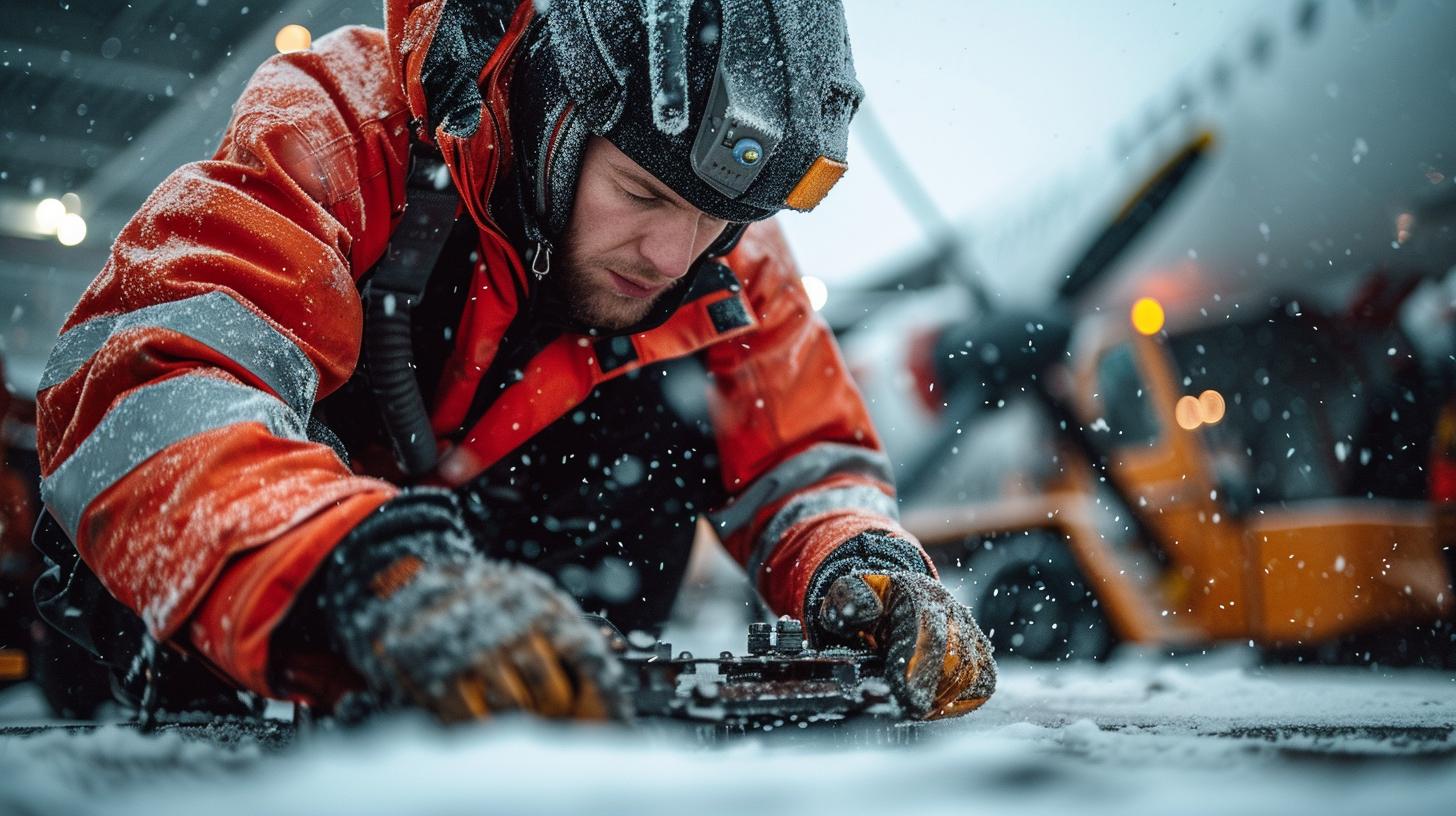As the winter season escalates, so does the frequency of flights operating in chilly, frosty conditions. With this surge in winter aviation comes an enhanced emphasis on flight safety, and one cannot underscore enough the importance of deicer parts in ensuring safe winter travels. Deicing plays a vital role in maintaining the operational integrity and overall safety of an aircraft amidst freezing temperatures and icy conditions.
The escalation of winter flights brings with it a unique set of challenges due to varying weather conditions including snow, sleet, and ice accumulations – hostile for any aircraft takeoff or landing. During these seasons, the margin for error is significantly reduced hence necessitating stringent safety precautions to ensure every voyage is a success. The stakes are high for airlines; with freeze-over issues capable of causing disruptions, delays – or worse – catastrophic accidents.
In such unforgiving environments, deicer parts act as unseen guardians offering protection against these cold weather risks. Each part works systematically – be it by preventing ice formations on wings or clearing windshields for better visibility – contributing immensely towards flight safety during winters. Thanks to these diligently working components that millions of passengers reach their destinations safely even under chilling circumstances.
This article aims to introduce you to the unsung heroes aboard your flights which put passenger’s safety at paramount during winters – deicer parts. Strap in as we dive into the world of deicers, exploring their functions, types, processes, maintenance practices and more.
The Hidden Heroes
What Are Deicer Parts?
Deicer parts, sometimes also referred to as anti-icing equipment, performs a crucial role in ensuring the safety of aircraft during cold weather conditions. These components provide heated surfaces or special surface coatings that ultimately prevent ice buildup on critical parts of the airplane, including wings, propellers, windshields, and control surfaces such as rudders and elevators.
The deicing system is essential because any ice that builds up can disrupt the airflow around these structures, which can drastically affect its lift capabilities and maneuverability.
Types of Deicer Parts
There are a variety of deicer parts used in different types of aircraft. One common type is referred to as a thermal de-icing system which functions by heating areas susceptible to icing. This heat may be generated electrically or through bleed air from an aircraft’s engine depending upon design preferences and fuel efficiency considerations.
The pneumatic boot is another popular type of deicing equipment found in many types of airplanes particularly those with propellers. It has a simple working principle where it inflates to break off accumulated ice due to inherent elasticity.
Next is the TKS Ice Protection System often implemented in smaller aircrafts. It leverages a glycol-based fluid that is released through small porous holes in specific panels positioned on the wing leading edges. The liquid sheds away icy formations while additionally creating a slimy layer that prevents further ice buildup during flight.
The Role of Deicer Parts
The role that deicer parts play inside an aircraft cannot be overstated. During winter months when freezing temperatures present an ongoing threat to safe aviation operations, these components guarantee optimum performance of planes by averting ice accumulation on their major control surfaces which could otherwise lead to disastrous outcomes such as loss of proper control or even crashes.
In-flight icing is one among many dangers pilots could come across but thanks to deicer parts they need not worry about this particular hazard. Ice accretion on propellers or engine inlets could severely reduce their output power whilst also increasing the drag. But operational thermal or pneumatic boots prevent such issues ensuring that the flight stays course without adverse weather interference. Indeed, quality deicer parts work silently behind the scenes as the unsung heroes of aviation safety during winters.
The Process
Deicer parts are an integral component of aircraft operation in winter conditions, ensuring safe takeoffs and landings. Their function is primarily to remove and prevent ice from forming on the aircraft’s wings, tail, and other crucial areas that could potentially impact flight performance.

The operation begins with the activation of the deicing system, usually controlled from the cockpit. Once activated, hot air from the aircraft engines is directed through tubes in certain critical areas of the craft like wings and tail surfaces where ice accumulation may affect control or lift. Here is a step-by-step breakdown of this process:
- Flight crew identifies potential ice buildup and initiates deicing sequence.
- Hot air is diverted away from engines to heat exchangers which then direct it towards critical sections.
- The heat melts any accumulated ice and prevents further buildup during flight. It’s then vented out into the atmosphere.
- In some deicer systems, inflatable rubber boots cover wing leading edges/other critical aerodynamic components. These cyclically inflate and deflate to break apart any formed ice.
A real-world example showcasing how vital deicer parts truly are unfolded over Michigan in 1997. A corporate jet fell from the sky after a significant ice buildup on its wings during flight. The investigation later revealed that even though the pilots had activated their anti-icing system, they forgot to switch on one valve that would have routed hot air over crucial deicer parts-resulting in tragic consequences.
This incident underscores not only how essential these parts are but also how important correct system usage can be. “},.
Maintenance
Caring for deicer parts is vital in ensuring their optimal performance, which directly affects the safety of winter flights. The primary focus of basic maintenance practices lies in preventing ice formation and ensuring efficient deicing. Here’s a high-level view of these practices:
- Conduct Regular Checks: A careful visual inspection should be executed frequently to ensure no components are damaged or worn out.
- Clean Deicer Parts: Accumulated debris can decrease the efficiency of deicer parts. Periodic cleaning is thus essential for optimal function.
- Perform Scheduled Replacements: Certain parts need replacing after a specified period or usage threshold to avoid a sudden malfunction due to wear and tear over time.
Neglecting maintenance of deicer parts could lead to serious consequences including the risk of mechanical failure owing to accumulated ice disrupting flight functions. This can jeopardize not only the aircraft but also passengers’ lives, making frequent maintenance checks imperative.
Aircraft operators need to place significant emphasis on monitoring and scheduling care for their deicer parts. Appropriate procedures help minimize component deterioration over time and maximize efficiency when it’s crucial during colder climates. Furthermore, regular check-ups allow identifying any potential issues early on, providing an opportunity for preventive intervention before critical damage occurs.
In summary, preserving prime condition of deicer parts through vigilant and consistent maintenance practices is fundamental to guarantee smooth winter flight operations. Embracing such practices not only enhances reliability during harsh weather conditions but also improves overall operational safety standards in aviation.
Common Challenges and Solutions for Winter Flight Deicing
Common Challenges in Winter Flight Deicing
Winter flight deicing presents numerous challenges, with each situation demanding a different response depending on the weather conditions and the particular aircraft type. One of the most prevalent challenges is freezing precipitation (snow, sleet, and freezing rain) that can accumulate on wings, tail surfaces, and other exposed parts of an airplane even as it descends or ascends through clouds or storms. This build-up can distort the shape of these parts and degrade their performance.
Another challenge is frost formation. Though less hazardous than freezing precipitation, frost can disrupt smooth air flow over an aircraft’s surfaces by creating roughness, thereby making its control surfaces inefficient. Frost may form due to cold-soaked fuel-fuel that has been so chilled that it causes condensation to freeze onto the tank surfaces from where it spreads on to other structures.

Role of Deicer Parts
Deicer parts play a crucial role in overcoming these winter-specific obstacles to ensure safe flights. For instance, these parts create localized heat to melt ice or used pneumatic power from engines to create physical movement against icing build-up on leading-edge surfaces such as wings or tail structures.
Rubber boots installed at the leading edges could be inflated alternately using compressed air so they crack and shed any ice accumulation during flight-a system which is rather prominent in turboprop aircrafts. Jets might incorporate electrothermal systems inducing heat into metal strips that melt off ice forming on their surface.
Tackling Challenges: Importance of Quality Deicer Parts
When tackling these winter-related challenges, the quality of deicer parts plays an essential function in securing seamless flights for passengers while also protecting expensive aircraft from damages likely instigated by weather adversities.
Substandard deicer parts not only reduce efficiency but can also lead to serious safety risks including compromised flight controls caused by iced up wing or tail surfaces. It’s therefore crucial to ensure that high-quality, reliable, and robust deicer parts are used in aircrafts to efficiently counteract the harsh winter conditions.
Moreover, it’s important to train ground crews adequately on the appropriate use of these parts during pre-flight deicing operations. With well-coordinated strategies that include adequate maintenance and substantial investments in quality components, many of the risks associated with winter icing can be effectively mitigated. Ultimately, quality deicer parts are as much the heroes of ensuring safe winter flights as the pilots skillfully navigating through bad weather.
Purchasing and Replacing Deicer Parts
Purchasing deicer parts for an aircraft is an important task. One cannot overlook the quality and efficacy of these vital components as they play a crucial role in ensuring the safe operation of flights during harsh winter conditions. There are multiple factors to consider while buying or replacing these parts, including their compatibility with your specific aircraft model, reliability, pricing, and warranty conditions.
One of the primary considerations when buying deicer parts is whether the part is compatible with your specific model of aircraft. Different types and models of airplanes may require variant kinds of deicers. For example, propeller deicers may be distinct from wing deicers in design and functionality.
Therefore, always ensure you consult with professionals or use reliable resources to ascertain that you’re purchasing correct components for your specific plane model. Besides compatibility checks, it’s also significant to consider the reputation of the manufacturer or supplier while purchasing these critical parts. It’s ideal to go with companies that are well-regarded in the aviation industry for maintaining high standards of product quality.
The cost-to-quality ratio should also be a key consideration when purchasing and replacing deicer parts. A lower price does not always mean better value if it compromises on safety or durability.
Long-term expenses can end up much higher if poorly manufactured parts fail prematurely or cause damage to other components of your aircraft due to their inferior quality. A robust warranty can also provide peace-of-mind during purchase – it allows you a certain level of financial protection if any issues arise within a specified time period after installation.
| Considerations | Explanation |
|---|---|
| Compatibility | Ensure the part is suitable for your specific aircraft model. |
| Manufacturer Reputation | Purchase from well-reputed companies known for product quality. |
| Cost-to-Quality Ratio | Consider long-term value over initial cost. High-quality parts may have a higher upfront price but will typically last longer and perform better. |
| Warranty | A strong warranty can provide financial protection in case of early failure or defects. |
Conclusion
The critical role of deicer parts in ensuring safe winter flights cannot be overstated. As observed throughout this analysis, these hidden heroes of aviation work tirelessly and seamlessly to keep ice from building up on the wings and other airplane components, hindering performance and potentially manifesting into dire circumstances. Consequently, the high-quality operation, maintenance, and timely replacement of these components persist as a paramount focus for airlines industry-wide.

As we’ve learned, selecting reliable deicer parts requires a thorough approach considering factors such as quality, compatibility with the aircraft model at hand, track record of effectiveness among others. Investing in top-tier parts signifies investing in safeguarding precious lives-the passengers-a reality that underscores adopting no compromise when it comes to purchasing these integral components.
Reliable manufacturers should provide accurate information about the life span of their products and have robust support services to cater to any queries or procedural guidance sought by aircraft technicians.
Lastly, beyond possessing prime quality deicer parts is the necessity for regular checks and maintenance. Ensuring that these components are always functioning optimally can be likened to proactively dodging possible future catastrophes; therefore rigorous schedule adherence is key.
In conclusion, while they may remain unseen and frequently unsung heroes in aviation safety narratives particularly concerning winter flights, deicer parts represent an indispensable fixture ingrained deeply within this domain. Their stealthy role continues to ensure that despite harsh winter conditions passengers can still enjoy safe and smooth flights all year round-an invaluable service indeed.
Frequently Asked Questions
What Is Deicer Made Out Of?
Deicer is typically made from a variety of components, including calcium chloride, magnesium chloride, sodium chloride (commonly known as table salt), and potassium chloride. It can also contain additives for enhancing ice melting capabilities like carbohydrates or corrosion inhibitors which protect vehicles and road surfaces.
What Is a Deicer Used For?
A deicer is used for removing ice from surfaces that it may accumulate on during frigid temperatures. These surfaces can include airplane wings and runways, car windshields, sidewalks, driveways and other paved areas. By lowering the freezing point of water, deicers prevent ice from forming and help melt existing ice quickly.
Can You Make Your Own Deicer?
Yes, you can make your own deicer at home with common household items. This might be a good option if you need to quickly clear ice from your car windshield or driveway and don’t have any commercial deicer on hand. A popular homemade mixture often includes rubbing alcohol and water.
Is Deicer Toxic to Humans?
While not typically lethal to humans in small quantities, some components of deicers can be harmful if ingested or come into direct contact with skin or eyes over an extended period of time. It’s always best to handle these chemicals properly by wearing appropriate protective gear and keeping them out of reach from children.
What Is the Difference Between Antifreeze and De-Icer?
Antifreeze and de-icers serve different purposes but work in a similar way: they both lower the freezing point of water thus preventing it from turning into ice under certain conditions.
Antifreeze is primarily used in vehicle cooling systems to prevent the water-based coolant from freezing while de-icers are used to remove or prevent the formation of ice on various surfaces.
How Do You Make Homemade Deicer Liquid?
To make homemade deicer liquid, combine two parts isopropyl alcohol with one part water in a spray bottle then shake to mix well – there’s your DIY version of a deicing fluid! This simple solution works effectively for melting ice off cars because isopropyl alcohol freezes at much lower temperatures than water does.
How Do You Make Homemade Ice Melts?
Making homemade ice melt is quite simple. One common approach involves mixing one teaspoon of dish liquid, one tablespoon of rubbing alcohol, and half a gallon of hot water. When this mixture is poured onto icy surfaces, the ice begins to dissolve due to the salt and heat from the hot water.
Is There a Natural Deicer?
While many deicers are commercially produced with various chemicals, there are natural alternatives available as well. A common example is beet juice which is often mixed with traditional rock salt or brine. In cold temperatures, beet juice helps to lower the freezing point for water on roads and walkways making it an effective, eco-friendly deicer.
